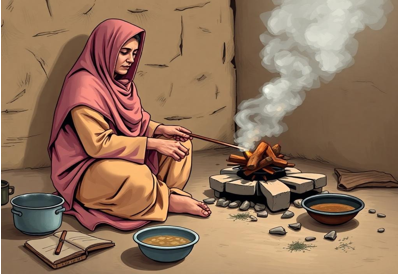INP-WealthPk
Amir Saeed
Pakistan lacks a holistic and multi-pronged coordinated strategy to address the barriers to the clean cooking energy access, forcing nearly half of its population to rely on low-cost or freely collected polluting fuels, with serious health, economic, environmental and climate impacts, WealthPK reports.

Currently, only 52% of the country’s population has access to the clean cooking fuels and technologies, while about 70% uses biomass fuels, especially in rural areas. Talking to WealthPK, Shafqat Hussain Memon, a researcher on energy access and rural electrification at Mehran University of Engineering & Technology, highlighted that although cooking with traditional fuels was not a new problem, it’s often overlooked. While access to clean cooking is deeply enshrined in SDG 7, nearly half of Pakistan’s population relies on low-cost or freely collected polluting fuels such as coal, charcoal, firewood, agricultural wastes and animal dung.
These populations face serious health, economic, environmental and climate impacts, making them vulnerable to energy poverty and hampering their ability to thrive. He also highlighted that around 23 percent of the population (50 million people) had no access to reliable electricity, while 8 percent lacked access to any form of electricity. Weak power grids and inadequate power network infrastructure, especially in informal urban settlements, limit the transition to electric cooking. Similarly, piped natural gas reaches only 25% of the population, mostly in urban areas, leaving the rural and peri-urban areas underserved and energy-deficient.
Pakistan falls behind in rural electrification through mini/micro-grid development, which is the only way for remote communities to access Tier 4 and 5 energy. Tier 4 and 5 energy is defined as access to modern energy cooking services, and it could be harnessed from the renewable energy sources. He pointed out that the country’s energy mix only contained about 5-6% renewable energy and the national centralized energy policy was largely unaligned with the decentralised renewable energy generation policies and programs. Additionally, there is a lack of comprehensive policies and national strategies for clean cooking access. “Let’s make clean cooking visible in the national policies to give it national priority.
If something isn’t visible, it won’t be prioritised,” he said. Despite being included in Pakistan’s National Clean Air Policy and some focus on biogas cooking by RSPN, clean cooking needs further integration into Pakistan’s Nationally Determined Contributions (NDCs) and energy policy, especially aligning with the Alternative and Renewable Energy (ARE) 2019 policy. “To scale up and accelerate the adoption of clean cooking technologies, there’s a need for technology transfer and indigenous development to lower the upfront costs. Financial mobilization remains a barrier, with carbon financing playing a key role in attracting investment to the clean cooking sector,’’ said Shafqat Memon.
Talking to WealthPK, Dr. Rihab Khalid, Research Associate at Modern Energy Cooking Services (MECS), Loughborough University, UK, said the MECS programme conducted a Global Market Assessment (GMA) for electric cooking to identify where the greatest opportunities and challenges for a scaleup of electric cooking in the global south lie. This assessment gives a score for each country based on its estimated readiness and viability for transitioning to e-cooking. Unfortunately, Pakistan ranked 85/130 countries according to this assessment. She highlighted critical reasons such as the limited energy infrastructure and economic barriers, including lack of financial mechanisms like microfinance or mobile money services, that can potentially provide support to such households.
She argued that as the GMA shows, these challenges go hand in hand with the lower ranking in Human Development Indicators. For example, socio-economic disparities, lack of awareness and education about the health and environmental impacts of polluting fuels, significant geographical disparities within and across provinces, and, very importantly, persistent gender inequalities all contribute to limited access to resources needed for sustainable energy and clean cooking solutions. She highlighted that there are other challenges as well, such as a weak market presence of clean cooking technologies, lack of quality control standards, and limited consumer trust or familiarity with these alternatives.
She suggested that carbon financing mechanisms can significantly support Pakistan’s transition to clean cooking. There are various financing models that can be employed. For example, results-based financing, where the funds are disbursed based on verified emission reductions. “The World Bank has undertaken many projects under this model, such as in Bangladesh where the it has supported the expansion of renewable energy through financial support to organisations installing solar home systems.
“Partnering with microfinance institutions such as Kashf Foundation to offer affordable payment plans or engaging in public-private partnerships like those seen with the Pakistan Poverty Alleviation Fund, can also facilitate progress. In terms of carbon credits for e-cooking, MECS’ collaborative ATEC Cook2Earn project is a good example that is currently being piloted in Bangladesh and Cambodia.” “This project effectively uses carbon credits to create a sustainable and incentivised model for adopting clean cooking solutions.
By monetising the environmental benefits of reduced emissions, the project lowers financial barriers for users and provides them with an opportunity to earn income—hence the name ‘cook to earn.’” The researcher concluded that Pakistan must adopt a holistic and multi-pronged coordinated strategy to address the barriers to clean cooking energy access. This includes focusing on policy development, regulatory reform, standardization, integrating financial mechanisms, market development, indigenous innovation, technology transfer, and public awareness initiatives.
Credit: INP-WealthPk






